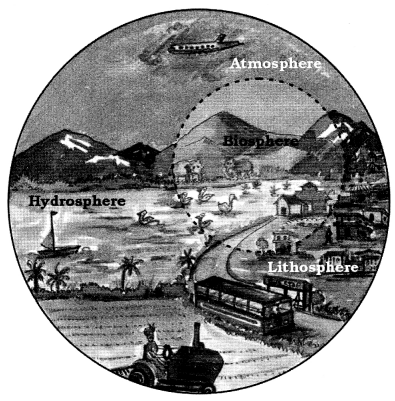MCQ Questions for Class 7 Geography Chapter 1 Environment with Answers
Students who are searching for NCERT MCQ Questions for Class 7 Geography Chapter 1 Environment with Answers Pdf free download are compiled here to get good practice on all fundamentals. Know your preparation level on MCQ Questions for Class 7 Social Science with Answers. You can also verify your answers from our provided Environment Class 7 MCQs Questions with Answers. So, ace up your preparation with MCQ of Chapter 1 Geography Objective Questions.
Environment Class 7 MCQs Questions with Answers
Appearing Students of Class 7 Exams can download MCQ on Environment Class 7 with Answers from here. By practicing Class 7 Geography Chapter 1 MCQ with Answers, you can score well in the exam. Download Class 7 SST Geography Chapter 1 MCQ in PDF format from the below access links and start practicing on a regular basis for better subject knowledge.
Question 1.
What is a source of mineral wealth?
(a) Atmosphere
(b) Biosphere
(c) Lithosphere
Answer
Answer: (c) Lithosphere
Question 2.
The domain of water is referred to as:
(a) Hydrosphere
(b) Atmosphere
(c) Lithosphere
Answer
Answer: (a) Hydrosphere
Question 3.
Who protect earth from the harmful rays and scorching heat of the Sun?
(a) Mechanical force
(b) Gravitational force
(c) Atmosphere
Answer
Answer: (c) Atmosphere
Question 4.
Which of the following is a human made environment?
(a) Hydrosphere
(b) Economic
(c) Industries
Answer
Answer: (c) Industries
Question 5.
When is the world environment day is celebrated?
(a) 5 July
(b) 5 June
(c) 5 January
Answer
Answer: (b) 5 June
Question 6.
What is Environer/Environner means?
(a) Environment
(b) Aquarium
(c) Neighbourhood
Answer
Answer: (c) Neighbourhood
Question 7.
WLich one has solid crust or the hard top layer of the earth?
(a) Lithosphere
(b) Hydrosphere
(c) Atmosphere
Answer
Answer: (a) Lithosphere
Question 8.
Plant and animal kingdom together made:
(a) Atmosphere
(b) Hydrosphere
(c) Biosphere
Answer
Answer: (c) Biosphere
Question 9.
Which one has thin layer of air that surrounds the earth?
(a) Atmosphere
(b) Biosphere
(c) Hydrosphere
Answer
Answer: (a) Atmosphere
Question 10.
The word environment derived from the French word “Environer” which means:
(a) Brotherhood
(b) Neighbourhood
(c) Childhood
Answer
Answer: (b) Neighbourhood
Question 11.
Which is not a component of human environment?
(a) Land
(b) Religion
(c) Community
(d) All of these
Answer
Answer: (a) Land
Land is not a component of human environment. Human beings make cars, mills, factories and roa(d) Human beings modify natural environment and thus known as human made environment.
Question 12.
Which is not a natural ecosystem?
(a) Desert
(b) Aquarium
(c) Forest
(d) None of these
Answer
Answer: (b) Aquarium
Aquarium is not a natural ecosystem. The relation between the living organisms as well as the relation between the organisms and their surroundings form an ecosystem.
Question 13.
What is the solid crust of the earth is called?
(a) Atmosphere
(b) Lithosphere
(c) Crust
(d) All of these
Answer
Answer: (b) Lithosphere
Lithosphere is the solid crust of the earth. It is made up of rocks and minerals and covered by a thin layer of soil. It is an irregular surface with various landforms such as mountains, plateaus, plains, valleys, et(c)
Question 14.
When is world Environment Day is celebrated?
(a) 5th January
(b) 5th June
(c) 5th August
(d) None of these
Answer
Answer: (c) 5th August
On 5 June every year the World Environment Day is celebrate(d)
Question 15.
What is the life support system among the following?
(a) Transportation
(b) Music system
(c) Environment
(d) Both (a) and (b)
Answer
Answer: (c) Environment
Environment is our basic life support system. It provides the air we breathe, the water we drink, the food we eat and the land where we live.
Match the following
1.
| Column I | Column II |
| 1. Landforms | (a) Domain of water |
| 2. Human made | (b) Bridges |
| 3. biosphere | (c) Communication |
| 4. Gravitational force | (d) Continents and ocean floors |
| 5. Information revolution | (e) Holds the atmosphere |
Answer
Answer:
| Column I | Column II |
| 1. Landforms | (d) Continents and ocean floors |
| 2. Human made | (b) Bridges |
| 3. biosphere | (a) Domain of water |
| 4. Gravitational force | (e) Holds the atmosphere |
| 5. Information revolution | (c) Communication |
Fill in the blanks
1. ……………. is our basic life support system.
Answer
Answer: Environment
2. Land, water, air, plants and animals comprise ……………. environment.
Answer
Answer: natural
3. ……………. is the solid crust or the hard top layer of the earth.
Answer
Answer: Lithosphere
4. ……………. system is a trade in which goods are exchanged without the use of money.
Answer
Answer: Barter
5. ……………. revolution enabled large scale production.
Answer
Answer: Industrial
6. Information revolution made ……………. easier and ……………. across the worl(d)
Answer
Answer: communication, speedy
7. A perfect balance is necessary between the natural and ……………. environment.
Answer
Answer: human
8. Natural environment comprises ……………. and ……………. conditions.
Answer
Answer: biotic, abiotic
9. Change in environment produces changes in ……………. .
Answer
Answer: weather
10. Human environment reveals the ……………., ……………. and among human beings.
Answer
Answer: activities, creations and interactions
Picture Based Questions
1. Draw a sketch of component of environment.
Answer
Answer:

2. Draw a picture stating domains of the Environment.
Answer
Answer:

Use the above-provided NCERT MCQ Questions for Class 7 Geography Chapter 1 Environment with Answers Pdf free download and get a good grip on the fundamentals of real numbers topic. Need any support from our end during the preparation of Environment Class 7 MCQs Multiple Choice Questions with Answers then leave your comments below. We’ll revert back to you soon.
MCQ Questions for Class 7 Geography Chapter 1 Environment with Answers Read More »



